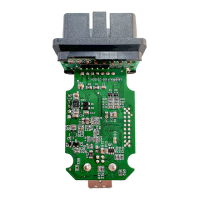Ethernet (ETH): media access control (MAC) with DMA controller RM0090
1134/1749 RM0090 Rev 18
Basically there are two operating modes of the MAC sublayer:
• Half-duplex mode: the stations contend for the use of the physical medium, using the
CSMA/CD algorithms.
• Full duplex mode: simultaneous transmission and reception without contention
resolution (CSMA/CD algorithm are unnecessary) when all the following conditions are
met:
– physical medium capability to support simultaneous transmission and reception
– exactly 2 stations connected to the LAN
– both stations configured for full-duplex operation
33.5.1 MAC 802.3 frame format
The MAC block implements the MAC sublayer and the optional MAC control sublayer
(10/100 Mbit/s) as specified by the IEEE 802.3-2002 standard.
Two frame formats are specified for data communication systems using the CSMA/CD
MAC:
• Basic MAC frame format
• Tagged MAC frame format (extension of the basic MAC frame format)
Figure 360 and Figure 361 describe the frame structure (untagged and tagged) that
includes the following fields:
• Preamble: 7-byte field used for synchronization purposes (PLS circuitry)
Hexadecimal value: 55-55-55-55-55-55-55
Bit pattern: 01010101 01010101 01010101 01010101 01010101 01010101 01010101
(right-to-left bit transmission)
• Start frame delimiter (SFD): 1-byte field used to indicate the start of a frame.
Hexadecimal value: D5
Bit pattern: 11010101 (right-to-left bit transmission)
• Destination and Source Address fields: 6-byte fields to indicate the destination and
source station addresses as follows (see Figure 359):
– Each address is 48 bits in length
– The first LSB bit (I/G) in the destination address field is used to indicate an
individual (I/G = 0) or a group address (I/G = 1). A group address could identify
none, one or more, or all the stations connected to the LAN. In the source address
the first bit is reserved and reset to 0.
– The second bit (U/L) distinguishes between locally (U/L = 1) or globally (U/L = 0)
administered addresses. For broadcast addresses this bit is also 1.
– Each byte of each address field must be transmitted least significant bit first.
The address designation is based on the following types:
• Individual address: this is the physical address associated with a particular station on
the network.
• Group address. A multidestination address associated with one or more stations on a
given network. There are two kinds of multicast address:
– Multicast-group address: an address associated with a group of logically related
stations.
– Broadcast address: a distinguished, predefined multicast address (all 1’s in the
destination address field) that always denotes all the stations on a given LAN.

